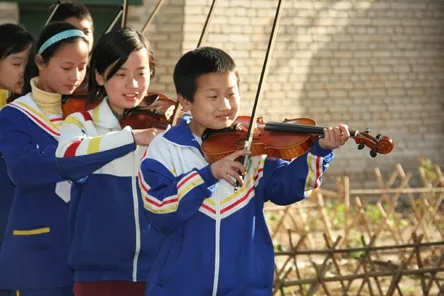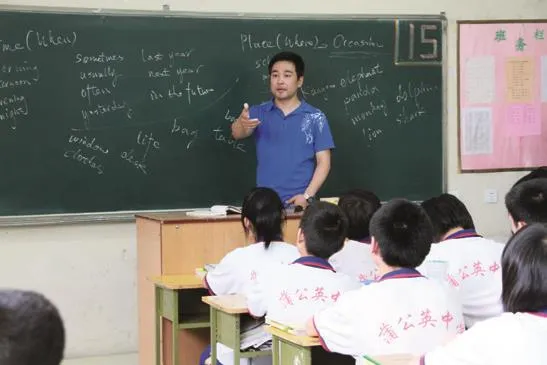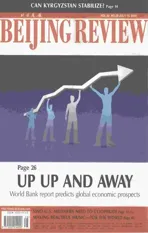Flying as a Dandelion
2010-09-12ByWANGHAIRONG
By WANG HAIRONG
Flying as a Dandelion
By WANG HAIRONG
In search of fair education for migrant children
On a drab street lined with low-rise shops, restaurants and shish kebab stalls, Dandelion Middle School is hardly noticeable. In the July rain, the run-down street in a Beijing southern suburb even looks a little dreary.
Behind a large, old-fashioned iron gate is the campus of Dandelion Middle School, the frst, also the only, government-approved middle school for children of migrant workers in Beijing. Currently, more than 600 students are enrolled.
The school’s name indicates the characteristics of its students, who are like dandelions, ordinary plants that need little to survive and can grow and bloom anywhere.
Right to education
Dandelion Middle School is a nonprofit private school established in 2005. Its founder, Zheng Hong seeks to give migrant children a quality education. Zheng holds a Ph.D. from the University of Geosciences in China and an MPA from Harvard University’s Kennedy School of Government.
The campus is clean and reasonably spacious. It used to be a factory producing switches. The paintings on the walls give it an artistic touch. A huge “welcome” sign adorns the wall beside the entrance gate in both Chinese and English.
Between classes, boys and girls play basketball or table tennis in the yard. Meals are usually brought to classrooms from the kitchen. After dinner, they study in the classrooms before returning to the dormitory at around 8:30 p.m.
The school has dormitories for students and teachers, a library, laboratories for numerous science classes, and an auditorium.
The classrooms and dormitories for Grade 7 are in a bungalow in the front yard. They were humid and stuffy after the rain. In a dormitory, several bunk beds were put next to each other. There were no tables, chairs or decorations of any sort.
Private migrant children’s schools came into being as migrant workers focked to cities, some bringing their children with them.
School-age children migrating to Beijing increased from about 66,000 in 1997 to 400,000 in 2008, according to research done by Liu Chengfang, a senior research fellow at the Center for Chinese Agricultural Policy at the Chinese Academy of Sciences.
Migrant children brought with them an educational conundrum in China—they could not access free compulsory education in urban public schools. According to the Compulsory Education Law of China published in 1986, local governments in their places of origin should be responsible for providing them free compulsory education.
As the number of school-age migrant children grew, education became a pressing issue. In 1998, the Ministry of Education and the Ministry of Public Security published a provisional regulation on schooling for migrant children. The provision gave a green light to private schools for migrant children, and permitted the schools to meet lower standards compared to regular fulltime schools.
After the regulation, migrant children schools mushroomed. Liu found the number of migrant children schools in Beijing went up from less than 50 in 1997 to about 200 in 2000. In 2008, about 300 such schools were still running.

PATH TO OPPORTUNITY: The gate of Dandelion Middle School in a Beijing southern suburb on July 1

PHYSICALLY STRONG: Girls in Dandelion Middle School in a physical education class
However, most of the private migrant schools are not authorized by the government. Some school headmasters and teachersthemselves are poorly educated. China Youth Daily reported one headmaster of such a school only had a two-year primary school education.
The father of a student surnamed Shang at the Dandelion Middle School talked about the experience he had with a private school for migrant children his son attended.
“That school was awful,” Shang said, accusing it of being more concerned with revenue than quality education. “As long as students were safe and sound in the school, the teachers felt okay. They did not teach much. In fact, I taught my son more than the teachers.”
Shang is a migrant worker in the clothing industry. He and his wife, natives of Hubei Province, came to Beijing after working in south China’s Guangzhou City, Guangdong Province, for several years. Shang brought his son with him wherever he worked. He says the teachers at Dandelion are very responsible.
“In Dandelion Middle School, we have taken several measures to ensure teaching quality,” said Cheng Jianfang, the school’s teaching supervisor. The school recruits teachers with educational backgrounds in normal schools and with teaching licenses. Teachers are required to write teaching plans and at times present them in front of other teachers and listen to each other’s classes. School leaders randomly drop into classes to monitor teaching quality.
“We can tell whether a teacher is devoted. If a teacher is devoted, he or she will do a good job,” Cheng explained.
These measures give incentives for teachers to improve. Because salary paid at the school is relatively low compared with the average teacher’s income in Beijing, it is difficult to attract experienced teachers from public schools, Cheng said. Most of the teachers working at the school are from other provinces, and did not have much teaching experience when they started. The school offers them on-the-job training and has a teacher exchange program with top middle schools in Beijing.
The students make progress at the school, Cheng said. Many new students did poorly when they just moved in. Last year, the school recruited 220 students and only fve of them passed all the three subjects at the entrance examination for junior middle school. After studying for three years, students took the same high-school entrance exams as regular students in Beijing. During the past two years, 98 percent of the students taking the exam passed.
“We not only improve the students’knowledge, but teach them to be a good person and improve their overall qualifcations,”said Cheng.
A student orchestra was set up with help from professors in the Central Conservatory of Music, China’s top music education institution. Some student paintings were exhibited in a museum in downtown Beijing in early July.
Dandelion Middle School is mainly financed by charity. Most students in migrant children’s schools are from low-income families, while wealthier migrant children usually pay high tuition and go to elite private schools or regular public schools, said Cheng.
The tuition and living expenses of poor students, about one third of the total, are covered by donations. The remaining students pay a modest tuition of 680 yuan ($100) per semester, rent of 50 yuan ($7.4) per month, and 6 yuan ($0.88) for three meals per day.
Volunteers from various organizations also come to the school to help. For instance, Duke University sends eight student volunteers to the school each year, and volunteers usually spend about three months there, said Kent Freeze, a volunteer coordinator and Ph.D. candidate from Duke. These volunteers mostly teach students English, and some also do research on student health.
Bright dreams

SOUND OF MUSIC: Members of the student orchestra of Dandelion Middle School practice on April 27
Research of randomly picked students reveal they aspired to go to universities andwould like to stay in cities when they grow up.
Migrant children in Beijing cannot take the university entrance exam in Beijing and be admitted on equal footing as students with permanent Beijing residence.
Ren, who came to Beijing at 6, said that her parents want to send her back to her hometown for her last year of middle school. She will fnish high school in her hometown and compete with students in her home province for one of a limited number of spaces in Beijing’s universities allocated to students there.
Most of the students would not like to return to their hometown as they have spent so many years away from it and consider Beijing home, Cheng said.
For students who will not or cannot go to regular high schools and universities, Dandelion Middle School has a training program providing students with internship opportunities in Beijing companies.
Policy support
The government has adjusted education policies to give migrant children better access to public schools in cities. In May 2001, the State Council issued a decision on elementary education reform, which stated that government and public schools should undertake the main responsibilities to give compulsory education to migrant children.
Article 12 of the amended Compulsory Education Law published in 2006 stipulates local governments should provide conditions for migrant children to receive equal education.
The Beijing Municipal Government further opened its public schools to migrant children. In the meantime, it strengthened management of unauthorized private migrant children schools. In 2006, it closed down some of these schools and ordered others to improve.
Liu Limin, head of Beijing Education Commission, told New Beijing Daily that currently 67 percent of the 420,000 school-age migrant children in Beijing are enrolled in public schools. Statistics from the Beijing Education Committee show that, at present the number of school-age migrant children is one third of schoolage children with Beijing permanent residence.
In January 2009, Beijing Municipal Government abolished fees for temporary enrollment in primary and middle schools. Under the new guidelines, migrant children, dubbed “new Beijing citizen,” will be treated the same as local children, said Han Jialing of the Migrant Workers Education and Action Research Center, Beijing Academy of Social Science.
Shortly before the National Day in 2009, the Beijing Municipal Government invested 13 million yuan ($1.91 million) to purchase equipment for the 69 government-authorized migrant children schools in the city. This was the first time the city gave a financial support to such private schools, reported Beijing Daily.
The Ministry of Education, together with six other ministries, issued circular this May, forbidding schools to charge migrant children temporary enrollment and other unreasonable fees.

VOLUNTEER IN ACTION: Ji Xiaojun, an anchor man at China Central Television’s English channel, teaches a class at the Dandelion Middle School on June 8 as a volunteer
